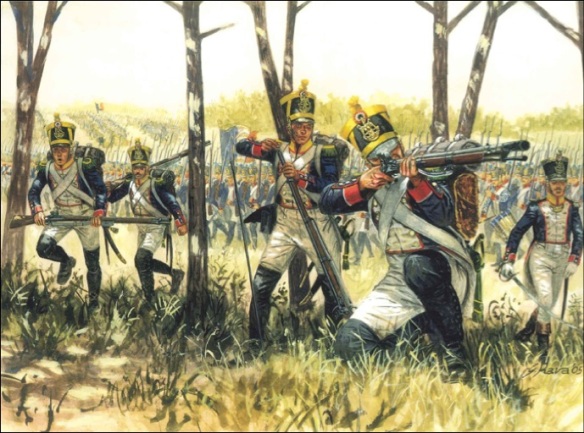After 1804, every French infantry battalion was authorized to establish a voltigeur company. These companies included the smallest and most agile men in the battalion and were expected to form the unit’s skirmish screen. They were marked by the green and yellow plumes and cording on the shako and similarly coloured epaulettes. voltigeur: from the French for “vaulter,” a light infantryman usually serving in the light company of a line regiment, usually deployed in extended order to form a skirmisher screen ahead of infantry or cavalry. As expert marksmen, voltigeurs carried .69 calibre carbines and any other weapons of choice.
DEPLOYEZ EN TIRAILLEUR! The French Army did not have a specific regulation for skirmishing, so individual regiments developed their own techniques, based on common experience of the Revolutionary Wars. Here a voltigeur company (1) has been sent several hundred paces forward to screen the battalion’s front. Before instructing his men to deployez en tirailleur, the captain designates the size of the intervals between each file. As the first two ranks advance at the pas de course, fanning out into open order, the third rank halts and is formed into two ranks by the sergent-major (2). Standing with the reserve, the captain (3) orders the halt. These orders were transmitted by drum or voltigeur horns. The captain could then order his men to fire in position or fire and advance by ranks. Each rank would advance a preset number of paces before firing; while they reloaded, the second rank advanced at the run. The reserve would keep pace, sending forward reinforcements as required. The lieutenant (4) and sous-lieutenant (5) would take position at the rear and centre of their sections. The sergents’ (6) positions were not fixed, so they could go where necessary. Skirmishers fought in pairs, either with their file partner or with the man to their right, ensuring that one of them remained loaded at all times. Although alignments had to be maintained, skirmishers would take advantage of any cover they found. The biggest threat to skirmishers was from cavalry, which could ride down a skirmish line rapidly. If the ralliement sounded, the skirmishers would run to the reserve and reform. If there was no time, they formed rally clumps around their section commanders, or took cover as best they could.
On 20 September 1804, Napoleon initiated a change in the battalion organization. The number of companies was decreased from nine to eight, and one company was also designated as a ‘light’ company of voltigeurs. For many units, this seems to have been a mere formality, as they had already designated one of their companies to serve as skirmishers on a regular basis.
Finally, there would be one more internal organizational change in 1808, when regiments were, in theory, to maintain their strength at four field battalions and one depot battalion. In each battalion, the number of companies would be reduced still further to six: four companies of fusiliers and chasseurs, depending on the type of regiment, one of grenadiers, or carabiniers, and one of voltigeurs. Depot battalions had no elite companies. Interestingly, this reflects a steady increase in the proportion of elite troops within the battalion – 11 per cent in the nine-company battalion, 25 per cent in the eightcompany battalion, and 33 per cent in the six-company battalion.
